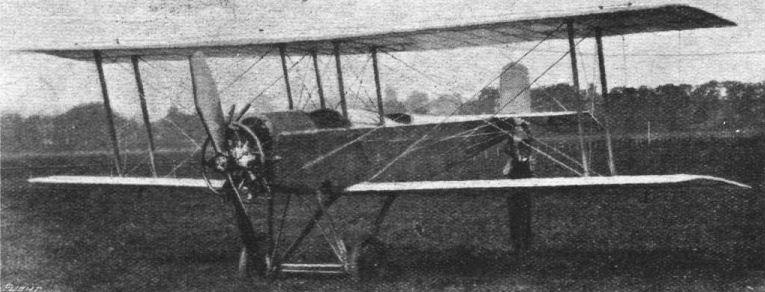
Описание
Страна: Великобритания
Год: 1914
Журнал Flight
Flight, July 19, 1917.
A NEAT SCHOOL MACHINE.
IN the training of a Service pilot it would often be an advantage if a machine were available on which, after having got to feel quite at home in the ordinary training machine, he could put in a little extra practice before making the admittedly somewhat long step to the high-powered fast Service aeroplane. It was with this object in view that the small biplane illustrated in the accompanying photographs was built. This machine, which was designed for the Wright Forge and Engineering Co., Ltd., of Tipton, Staffs., by Mr. W. West wood, is a light two-seater, fitted with a 40-45 h.p. Anzani engine. It is stated by the designer to have a speed range of from 30 to 65 m.p.h., and its climb, although not measured, appears to be quite good.
The upper and lower planes are of the same span, and both are fitted with ailerons interconnected in the usual manner. The top plane is built up in three sections - a centre section and the two outer main sections. The bottom planes are, as in the majority of modern biplanes, attached to the sides of the body. Structurally the wings are built up of ash spars reinforced with steel, and of ribs having spruce flanges and three-ply webs. The leading and trailing edges are of spruce, except for the tips, which are steam-bent ash. As will be seen from the illustrations, there is only one pair of inter-plane struts on each side, the machine following in this respect the lines of a fast single-seater scout.
As regards the wing bracing, this is effected by a somewhat unusual combination of steel tubes and stream-line wires. The lift "wires" consist of streamline steel tube measuring 1/2 in. in width by about 3/16 in. thick, and of R.A.F. wires. The landing "wires" are steel tubes only. External drift wires run to the nose of the body, and assist the internal wing bracing, which is in the form of stranded cable.
A flat non-lifting tail plane is secured to the top of the body and stayed with stream-line steel tubes. To the trailing edge of the tail plane is hinged the divided elevator, which is operated by means of stranded cables from an external crank lever on the side of the body. The rudder is hinged to the stem post of the body, and is partly balanced by a forward projection as shown in the illustrations.
Aerodynamically the body is of the ordinary flat-sided rectangular section type, but constructionally it differs somewhat from the majority of other aeroplane bodies. The designer argues - quite rightly, we think - that for a school machine, which is subject to many and frequently rough landings, it is important that the body should be a strong one. This end is attained in the present machine by an internal construction of the ordinary girder type, with four ash booms and ash and spruce struts in front and rear respectively, the whole being braced with piano wire, supplemented by a covering of three-ply extending the whole length of the body and screwed to rails and struts so as to minimise the danger of short breaks in the rails. A similar body has, we understand, stood up to a nose dive into the ground from a height of about 100 ft. This happened to a monoplane having a similar body.
The pilot's and passenger's seats are arranged tandem fashion, the pilot occupying the rear ore. The instruments comprise: Altimeter, revolutions counter, air speed indicator, switch, throttle and air control.
In the preliminary tests, which were carried out by Mr. Rene Desoutter at Dunstall Park, Wolverhampton, the machine did not show any tendency to spin, and refused, we are informed, to do a tail-slide when stalled to a vertical attitude in the air, the machine coming out in a nose-dive from this attitude. The following are the chief characteristics of the machine :-
Length, 22 ft.; span, 26 ft.; chord, 5 ft.; gap, 5 ft.; weight empty, 720 lbs.; area of wings, 245 sq. ft.; area of tail, 15 sq. ft.; area of elevators, 10 sq. ft.; area of rudder, 6,75 sq. ft.; engine, 40-45 Anzani; propeller, Lang; speed, 30 to 65 m.p.h.
Описание:
- Журнал Flight
- M.Goodall, A.Tagg British Aircraft before the Great War (Schiffer)
Фотографии
-
Журнал - Flight за 1917 г.
THE W.F. AND E. CO. BIPLANE. - Three-quarter front view.
-
Журнал - Flight за 1917 г.
W.F. & E. biplane. Built at Tipton in 1914 and tested by Rene Desoutter at Dunstall Park.
-
Журнал - Flight за 1917 г.
THE W.F. AND E. CQ. BIPLANE. - Side view.



